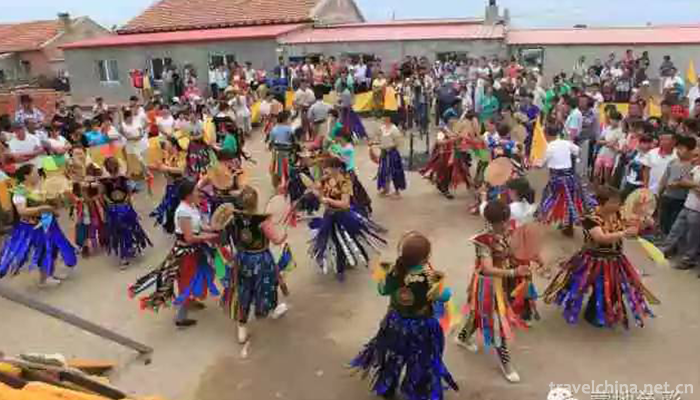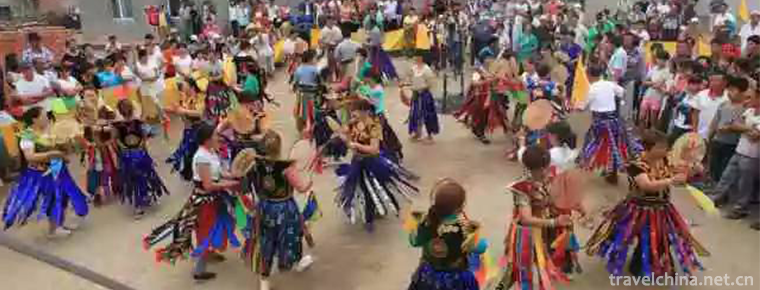Bo dance
Bo dance
Horqinbo dance, a primitive religious dance, is a form of Mongolian Bo (Shaman) "Xingbo" (Dancing God) and sacrifice. It is characterized by the combination of inspiration, singing and dancing, and has the characteristics of self-entertainment, competitiveness and play, which contains teaching in appreciation and entertainment.
origin
"Shaman" originates from the Chinese translation of Tungusian, meaning "a person who dances with excitement". History books generally refer to "Hu Wu", Mongolian people refer to male Shaman as "Bo" and female Shaman as "Odugan". Horqinbo dance is mainly used for offering sacrifices for blessings and exorcising evil spirits and curing diseases. Sacrifices for blessings are usually held in outdoor venues, including sacrifices to heaven and earth, ancestors, fire, thunder, mulberry trees, Aobao and rain, while exorcism and treatment are carried out at night at the home of patients.
details
When Bo dances, his skirt floats like a bird's wings and a horse's feet. In addition, the flickering of bronze mirrors and the sound of loud impact, the sound of drumming and shaking, make people dazzled and feel majestic. Horqin Bo Dance is mainly performed by Bo himself. When "Bang Bo" (two gods) participate in it, there are two-person dance and four-person dance. Their travel process and performance sequence are preparation, altar setting, dressing, table setting, elf box and sword. The first section invites God to worship and dance. The dancer's mood is sacred and pious, mainly singing, accompanied by simple footwork and "eight worship" movements. The second part of Shenlai Dance, the dancer's emotional fanaticism and confusion, with fierce rotation and jumping movements as the main, to dialogue, began to exorcise the evil and cure the disease, divination auspicious. Some Bo also danced Elf Dance according to the gods he came from. "Spirit Dance" is named for its imitation of totem gods, such as "Bird God Dance" and "Tiger God Dance". Most of them are singing and dancing, with rich movements and vivid images. The third part is for the entertainment of God dance, performing "Drum Dance" and "Elf Dance" with drumming skills throughout the dance. "Drum Dancing" moves lightly, skillfully and skillfully, drum point rich and changeable. "Elf Dance" adds gameplay to attract audiences and achieve the purpose of entertaining both people and gods. The fourth dance is basically the same as the first one.
"Laiqing" is a branch of Horqinbo, which is the product of the fierce struggle between Lamaism and Shamanism, so some people call it "Lamaibo". Lai Qing sat on a stool, beating radicals and chanting classics for treatment. Lai Qing's teacher-successor relationship and apprenticeship ceremony are the same as Bo's. But its costumes, instruments, dance movements, performance forms and music accompaniment are different from Bo. Dance is divided into cymbal dance, knife dance and bare-handed dance with different props, without drums or rotations.
Many Bo dances in Horqin are basically the same, but with different styles. Its artistic style of singing and dancing and drumming has been used for reference and developed by the new Mongolian dance art.


-
1.Lake Manasarovar
Ma Pang yongcuo is 35 kilometers east of the town of Pu Lan county
Time 2018-10-12 -
2.China Maritime Museum
China Navigation Museum, fully known as "Shanghai China Navigation Museum", is the first national navigational Museum approved by the State Council. It is co-constructed by the Ministry of T
Time 2018-12-22 -
3.Production Techniques of Dezhou Braised Chicken
Dezhou Grilled Chicken is a kind of poultry meat product cooked slowly in small fire. It is originally produced in Dezhou City, Shandong Province. It is also known as Dezhou Wuxiang Boneless Grilled C
Time 2019-04-26 -
4.End drum cavity
Weishan Lake Drum Tune, also known as Duangong Tune, is a traditional folk art of the Han nationality originating in Weishan County and Dongping County of Shandong Province
Time 2019-04-28 -
5.Lishui drum words
Lishui Drum Ci is a popular rap art in Liandu and its surrounding areas in Lishui City, Zhejiang Province. Lishui Drum Ci originated from the Tang Dynasty. During the reign of Emperor Li Shimin, it wa
Time 2019-05-13 -
6.Two instruments boxing
Liangyi Quan originated from Zhouyi, which said, "It's so easy to have Taiji. It's the birth of Liangyi". (Liangyi Quan) is also called Liangyi Point-through-Qishen Quan. Its name is formed
Time 2019-05-13 -
7.Qianshan Temple Music
Qianshan, located 20 kilometers southeast of Anshan City, Liaoning Province, is one of the most famous scenic spots in the country. In the northeast, Qianshan is as famous as Changbai Mountain in Jili
Time 2019-06-10 -
8.Mulberry Paper Making Skills
Mulberry paper is pale yellow. Mulberry paper with exquisite craftsmanship has obvious fiber structure. Mulberry paper is basically used as the page in local government books and books formed in Ming
Time 2019-06-12 -
9.Turkish Wheel Autumn
There is a beautiful and magical legend about the origin of Tu's wheel autumn. Legend has it that in order to find a way out of life, the ancestors of the Tu nationality ploughed their fields successi
Time 2019-06-23 -
10.The eldest son drum book
The eldest son drum book is the traditional art of rap and singing in Shanxi Province. Changzi County is known as the "Town of Quyi", which has a long history as well as a wide variety of Qu
Time 2019-07-25 -
11.Geographical environment of Mianyang
Mianyang City is located in the northwest of Sichuan Basin, in the middle and upper reaches of Fujiang River, bordering Qingchuan county and Jiange County of Guangyuan City in the East, Shehong city and Daying County in Suining City in the south, Luojiang
Time 2020-12-14 -
12.Safety production in Leshan
By the end of 2018, there were 81 production safety accidents in Leshan City, with 73 deaths and a direct economic loss of 19.0522 million yuan. Among them, there was one major accident and no major or above production safety accident. In 1132 traffic
Time 2020-12-17